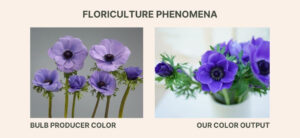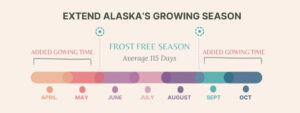Project Overview
Commodities
- Additional Plants: other
Practices
- Crop Production: season extension
- Education and Training: farmer to farmer
- Sustainable Communities: quality of life
Proposal summary:
Problem & Solution: This project addresses increasing the short 115 Day growing season in Alaska’s zone 3/4 by implementing our developing hybrid season extension model merging sustainable season extension systems. The focus is on finalizing the most energy-efficient and practical portions of our inspiration.
The significance to advance sustainable agriculture: By increasing the production period by at least 4 months we improve profitability for local growers with a 50% increase by doubling the season.
A Need: The research will also document daylight-driven floriculture phenomenon in four cut flower categories Dahlias (tuber) Tulips (bulbs) Anemones (Corm) and Snapdragons (seeds) at high latitudes, offering valuable insights to both local and global growers on how extreme daylight conditions change crop outcomes.
Significance in Advancing Sustainable Agriculture: Understanding color changes due to latitude-driven daylight variations enables accurate crop predictions, crucial for meeting florist demand. With 30 florists purchasing from us seasonally, confidently anticipating these color shifts allows for more precise sales projections and targeted marketing strategies. This not only strengthens relationships with our buyers but also ensures we meet market demand with high-quality, well-timed products, advancing sustainable practices in floriculture.
Dissemination: The findings will be shared through blog posts, podcasts, fact sheets, in-person tours, and videos, reaching cold-climate growers and agricultural stakeholders. This project aims to not only improve flower and food crop production but also enhance community resilience and sustainability by reducing reliance on imports and strengthening local economies through a well-thought-out, replicable, and cost-effective hybrid model.
Project objectives from proposal:
Research Objectives:
#1 Test Our Developing Alaskan Hybrid Season Extension Model for Zone 3/4 : Merging the energy efficiency and profitability by creating a custom hybrid season extension system inspired by Deep Winter Greenhouse, Walipini-style in-ground design, hydronic circulatory heating, and biomass fueling, tailored to Alaska's zone 3/4.
#2 Extend our limited 115 Day Growing Season by 4 Months: Given Alaska’s frost-free period only lasts from May to August, extending by 4 months will significantly increase profits and surpass the capabilities of high tunnels. March/April > (May to August) < September/October
Adapt for Food Production: Explore the feasibility of adapting these methods to food crops to improve food security in cold regions.
#3 Document High-Latitude Floriculture Phenomena and Share Findings: Photograph extended daylight-driven characteristic changes in flower growth and in high-latitude regions to provide reliable production expectations for growers.
Educational Objectives:
#1 Digital Asset Creation: Create a series of easy to digest educational assets for blog posts, podcasts, videos and handouts to communicate findings on season extension methods and latitude-driven floriculture anomalies.
#2 Local Grower Demonstration: Host a small-scale demonstration in Fall 2026 for local growers to observe season extension methods firsthand. This event will serve as a foundation for producing a video for wider outreach.
#3 Sharing Findings with a Broader Audience: Produce and distribute a video overview and downloadable factsheet to share the project's key findings with growers in cold-climate and underserved regions. Share a presentation at the Utah Urban and Small Farms Conference during the cut flower session. Share blog post progress throughout the project and distribute via social media. Conduct interviews with key experts and share debriefs on the podcast.

